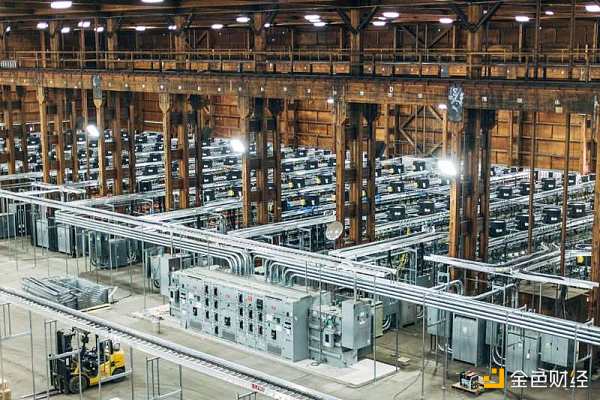Source: Sing Tao News
Bitcoin halving countdown begins! When the first Bitcoin was issued, the total issuance of Bitcoin was set at 21 million. Halving is an important element designed to control the circulation speed of Bitcoin. In the Bitcoin network, a new block is generated every ten minutes, and these new blocks are generated through the process of "mining". Bitcoin halving will make the supply of Bitcoin mining scarce, so it is usually considered a bullish event. What is the process of "mining"? Will the mining industry continue to exist in the context of Bitcoin halving?
Everyone can become a miner, but personal computing power is too low
Bitcoin "mining" can be understood as miners using mining machines to help Bitcoin network keep accounts, thereby obtaining Bitcoin (BTC) rewards. "Miners" are people who own mining machines and work for the Bitcoin network; "mining machines" refer to tools that work for the Bitcoin network, such as computers.
According to the principle of Bitcoin "mining", in fact, everyone can become a miner. This was indeed possible in the early days when the computing power of the entire network was low. Individuals could mine more Bitcoins using computers, and the difficulty was not high, which could be understood as free mining. However, in recent years, the iteration and update of mining machines has been very fast, and the computing power of new mining machines is very large. Therefore, if an individual purchases an old mining machine with low computing power, it will seriously affect the income; if a large mining machine is purchased but not joined into a mining pool, the computing power of a single mining machine is also very small relative to a large mining pool, and the chance of mining Bitcoin is also very small. Even if Bitcoin is mined, the gains cannot offset the mining costs, including mining machines, electricity costs, operation and maintenance costs, etc. At present, Bitcoin mining is showing a trend of specialization and industrialization, and the mining industry is gradually dominated by institutions or enterprises.
Where will Bitcoin miners go?

China's Bitcoin mining volume once accounted for two-thirds of the global total. From September 2019 to April 2020, Chinese miners accounted for more than 71% of the total network computing power.

Because the country is worried about the related financial risks and excessive energy consumption, rectification began in 2021.

Bitcoin miners have begun to look for suitable footholds around the world, transferring their businesses to the United States, Canada, Iran, Kazakhstan, Russia and northern Sweden. (The picture shows the mine in Kazakhstan)

In the United States, Texas was the first to accept cryptocurrency business. (Pictured is the Channing Mine in Texas)

But after the Bitcoin mines run by Chinese were exposed in the media, they had to find a new place to go and set their sights on Ethiopia, Africa, where electricity costs are low and policies are friendly.
The Great Migration of Bitcoin Miners From Texas, USA to Ethiopia
In fact, China's Bitcoin mining volume once accounted for two-thirds of the world's total. From September 2019 to April 2020, Chinese miners accounted for more than 71% of the total network computing power. As an energy-intensive industry, mining has become a hot destination for cryptocurrency companies due to its abundant and cheap electricity and hardware equipment. Earlier, Bitcoin mining was mainly concentrated in provinces with abundant and cheap electricity resources, including Sichuan Province, Inner Mongolia Autonomous Region, Xinjiang Uygur Autonomous Region and Yunnan Province. However, due to the country's concerns about related financial risks and excessive energy consumption, it began to rectify in 2021, causing Bitcoin miners to start looking for suitable footholds around the world and move their operations to the United States, Canada, Iran, Kazakhstan, Russia and northern Sweden. In the United States, Texas took the lead in accepting cryptocurrency businesses. The governor of the state also hopes that Texas will become a new global Bitcoin mining center. Shenzhen-based BIT Mining has also invested $26 million in a 57-megawatt facility in the state. According to the New York Times, Chinese-owned or operated Bitcoin mines have been found in at least 12 states in the United States, including Arkansas, Ohio, Oklahoma, Tennessee, Texas and Wyoming, consuming energy equivalent to the electricity consumption of 1.5 million households.
But after the Bitcoin mines operated by Chinese were exposed in the media, they had to find new places to go and set their sights on Ethiopia, Africa, where electricity costs are low and policies are friendly. Luxor Technology, a cryptocurrency mining service provider, estimates that Ethiopia has become one of the world's largest recipients of Bitcoin mining machines. The Ethiopian National Electric Power Company said it has reached power supply agreements with 21 Bitcoin miners, 19 of which are from China. As a result, Ethiopia will become one of the most popular destinations for Chinese miners.


 Catherine
Catherine JinseFinance
JinseFinance JinseFinance
JinseFinance Bitcoinist
Bitcoinist Bitcoinist
Bitcoinist Bitcoinist
Bitcoinist Cointelegraph
Cointelegraph Bitcoinist
Bitcoinist Bitcoinist
Bitcoinist Bitcoinist
Bitcoinist